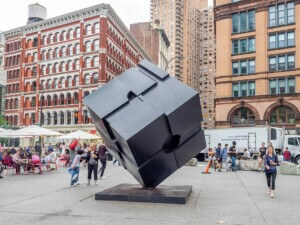Exemplifying the eternal Robert Moses-Jane Jacobs dialectic, New York’s Astor Place-Cooper Square area has long reflected too much Bob and not enough Jane. Excessive vehicular space has bred human-car conflict points, with pedestrians facing “a super-wide roadway . . . unclear at various traffic lights which way you are supposed to cross,” as noted by Claire Weisz of WXY (formerly Weisz & Yoes). The neighborhood around Cooper Union has become a midrise mélange, ill-serving its role as a campus and gateway between NoHo and the East Village. The chief open space is the under-lit, fenced-off Cooper Triangle, habitable mainly by rodents: A wasted opportunity in the park-starved area between Washington and Tompkins Squares.
Change hasn’t come quickly, but it’s coming. WXY has partnered with the Department of Design and Construction (DDC), Transportation (DOT), and Parks and Recreation (DPR), as well as with landscape architect Quennell Rothschild & Partners, lighting designer Linnaea Tillett, plantsman Piet Oudolf, and contractor Triumph Construction, to remap streets and upgrade the plazas. Adhering closely to the 2011 iteration of a plan vetted in community meetings since 2008, the team is creating an environment that blends landscaping and infrastructure: high-efficiency lighting, granite benches, stepped seating, bicycle racks, a new water main, catch basins, center medians, bioswales, and a dignified allée framing the Foundation Building. Construction began in 2013, and DDC projects opening this summer.
Anticipating Vision Zero by several years, Weisz said, “The plan tried to rationalize the desire lines with the actual street layout,” correcting dangerous conditions. At Fifth and Sixth Streets, “you would find yourself in the middle of Third Avenue without being able to cross the street at a normal crosswalk,” and the subway-entrance island between Eighth and Ninth was “really narrow for the amount of people on it.” With vehicles banned from eastern Astor Place and from Cooper Square below Sixth Street, “you’ll be able to walk pretty easily from Fifth Street all the way to the subway without having to cross traffic.” A tree-lined Alamo Plaza will replace two lanes of Astor Place, and an 8,000-square-foot Village Plaza will emerge from Cooper Square’s west sidewalk, replacing disorienting lanes and dead zones of striped-off asphalt.
“Essentially, the goal is to continue to encourage the street ballet of the neighborhood,” Weisz said.
“We believe this particular design takes the approach of Jane Jacobs to create spaces that favor the community,” said DDC spokesperson Shavone Williams, stressing community outreach from design through construction.
The DDC “was very much a co-designer on this rather than a client working with consultants,” Weisz said. “[The collaboration was] amazing—we have three agencies, almost with equal billing here, and two community boards.” Maintenance partners include Village Alliance for the Alamo and subway plazas, DPR for Cooper Triangle, and Grace Church School for the Village Plaza.
WXY’s design signature includes zipper benches and environmentally friendly cast-iron drinking fountains developed for DPR (shaped to accommodate water bottles and to vent wastewater into planters and gravel, not hard pipes). Distinctive black cobra-head davit poles will support energy-efficient LED fixtures above Village Plaza. Swales will enhance storm drainage, reducing combined sewer overflows. Tony Rosenthal’s rotating cube Alamo, currently off-site for restoration, will return to its original position.
Village Alliance, City Lore, and other cultural activists have worked with DOT to reinstall components of Jim Power’s Mosaic Trail—“a treasure map” revealing local history, said Bowery Poetry Club proprietor Bob Holman, a City Lore board member. “That the city, which has so long ignored this treasure, is helping to renovate the poles displaced by the renovation and will install them as a piece of public art,” Holman said, “is New York City at its best.” With varied color temperatures distinguishing pedestrian spaces, streets, and buildings, the team expected that “Power’s ceramics would really pop.”
Weisz foresees a return of informal vibrancy as the plazas draw lunchers, seniors, performers, students, and others (Though not nocturnal revelers: The Triangle will be locked at night). By inviting people to linger, these plazas may help energize local businesses assaulted by chain stores and rocketing commercial rents.
Interruptions in Manhattan’s street grid represent the revenge of the organic and historic against the hyper-rational. Sites that syncopate the 1811 plan’s marching rhythm are both robust and sensitive: They are activity magnets, yet they create welcome eddies in urban flows.










